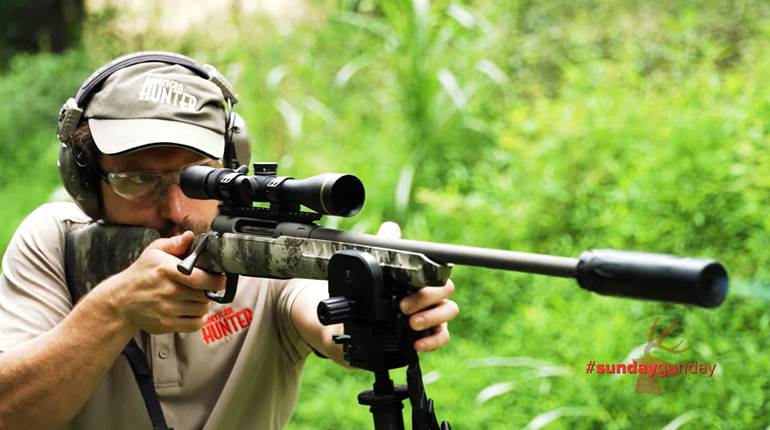
John Browning’s M1911 pistol has been with us for more than 105 years now, and it is still a viable gun for personal defense, military use and competition. Manufactured by numerous companies, the M1911 pistol’s longevity is a tribute to its sound design. The Italian firm of Tanfoglio has combined the century-old mechanism with modern polymer manufacturing to produce a new take on the classic single-stack M1911. Imported by European American Armory, the polymer-frame Witness Elite 1911 Polymer .45 ACP pistol weighs 25 percent less than a comparable steel-frame M1911, without sacrificing accuracy or controllability.
The keys to the Witness Elite’s frame are the two steel inserts that handle the firing stresses, incorporate the gun’s frame rails and locate critical pins. A simple roll pin is used to retain the forward insert within the synthetic frame. It combines the feed ramp and the bottom barrel lug recess, as well as the hole for the slide stop pin, which captures the barrel’s link. The inserts also have slide rails machined into them to ensure there is no metal-to-plastic contact. To facilitate feeding, the feed ramp has been polished.
The rear insert slides into the back of the polymer frame and is retained by the two upper “stock screws.” It has an integral ejector machined into it. The rear insert also contains the holes that locate the sear and hammer pins. In this way, there is no possibility of the holes becoming elongated or cracking, as would be possible if they were part of the polymer frame. Tanfoglio also laser engraves the gun’s serial number onto the rear block insert. There’s a steel plate inserted along the dustcover’s Picatinny rail section with the same serial number.
Tanfoglio uses standard mil-spec dimensions for the rail, so it will accommodate any number of tactical lights and lasers. Faux stock panels are molded into the frame and are checkered to provide the shooter with a secure grip. The gun’s frontstrap has been left untextured. Tanfoglio solved one of the original weak points of the M1911 by molding an integral plunger tube into the frame, eliminating any chance of the part loosening and disabling the thumb safety.
In addition to the frame, Tanfoglio also makes a number of other parts on the gun from polymer. The arched mainspring housing is polymer, as is the magazine release, recoil spring cap and guide and trigger stirrup.
Tanfoglio outfits the polymer Witness with a steel beavertail grip safety and a standard manual thumb safety, which engages and disengages crisply. A number of our evaluators opined that they would prefer the pistol have an extended thumb safety for more sure manipulation and a shelf on which to rest while firing. Fortunately, most M1911 aftermarket parts, including the thumb safety, will work with the Witness Elite 1911 Polymer pistol—though the safety may require some fitting to its sear.

There’s really nothing different about the pistol’s top end that would differentiate it from a standard M1911’s slide and barrel. In fact, the slide assembly could easily be used on a steel- or aluminum-frame gun without any modifications. Tanfoglio uses a stainless steel, match-grade barrel. It is throated and polished to feed most bullet profiles. The slide itself is machined from a nickel-steel alloy and is finished with a utilitarian, flat, black-oxide treatment. Its ejection port is lowered and flared for positive and unimpeded ejection, and an original-style internal extractor is used. Both sights are dovetailed into the slide and are drift-adjustable for windage. Together they present a bold sight picture.
To test the gun’s accuracy, we set our targets out at 25 yds. and fired all groups from a seated rest utilizing a Millett Benchmaster for support. Five groups were fired with each ammunition, with the results tabulated nearby. The Witness Elite 1911 Polymer exhibited excellent accuracy, with all loads tested averaging near 1.5" groups at 25 yds. The clean sight picture of the gun, combined with its crisp, 4-lb. trigger pull, made shooting the Witness Elite a pleasure. Black Hill’s 230-gr. FMJ load produced the best accuracy, averaging under an inch for all five groups and yielding the single best five-shot group, which measured just 0.82".
In field shooting, there was no discernible difference in time between shots while performing controlled pairs with the polymer Witness and a steel-frame M1911. Recoil seemed just a tad snappier than the steel-frame gun, but was very manageable. Our sample gun provided excellent reliability with no stoppages or failures of any sort during our 400-round evaluation.

The Witness Elite 1911 Polymer pistol fieldstrips in the same manner as any other M1911. Tanfoglio does not recommend removing the steel inserts from the frame for routine cleaning. There is nothing to be gained with their removal, and the pistol can be thoroughly cleaned with them in place.
Tanfoglio has done an exemplary job of taking an established design and modernizing the manufacturing process to create a lightweight version of a proven pistol, without changing its operating characteristics. At a suggested retail price of $580, the EAA Witness Elite 1911 Polymer pistol should appeal to those in search of a lightweight M1911 for sport or defense.





































